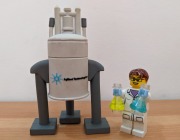In our group we study molecules inside porous materials using solid-state nuclear magnetic resonance (NMR) enhanced with dynamic nuclear polarization (DNP). As part of this work, we develop DNP-NMR techniques.
DNP is a method of enhancing the NMR signal. In DNP, we irradiate with microwave (MW) irradiation on paramagnetic centers (unpaired electrons), and the interaction between the electron spins and the nuclear spins results in enhancement of the NMR signal.
We are starting several exciting projects in the lab, all of which involve both NMR and DNP:
- Carbon sequestration: There is a pressing need to lower the CO2 concentration in the atmosphere, which can be accomplished by storing CO2 emissions underground. We study the mineralization reactions of CO2 with underground rock formations. This process has the potential to permanently fix the CO2 underground so it does not contribute to the greenhouse effect, but more research is necessary for it to become cost-effective and practice.
- Stone consolidation: Stone consolidation is a method of strengthening and protecting stone structures by impregnating the pores of the stone with materials that mineralize inside the pores. It is a vital tool for the conservation and protection of stone cultural heritage and without it priceless stone items will inevitably be destroyed.
- Residual molecule analysis for archaeology: We explore developing methods for the identification of organic molecules entrapped inside pores of clay pottery for residual molecule analysis, without the need to extract them from the pores. Residue analysis is used in archaeological science as a way to identify how clay vessels were used by identifying what the vessels contained, which is an important part of understanding the past.
![]()


